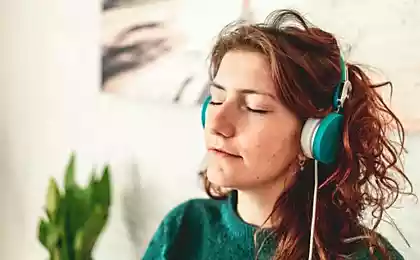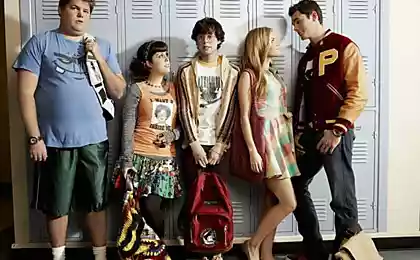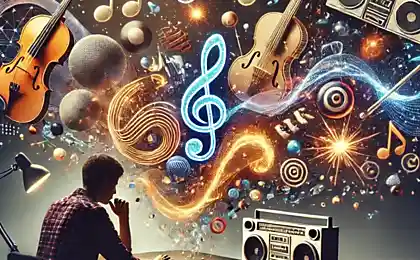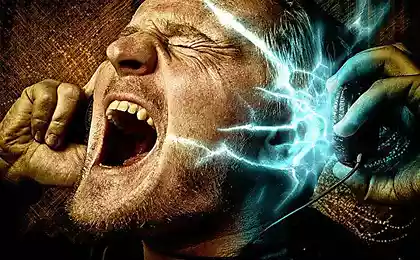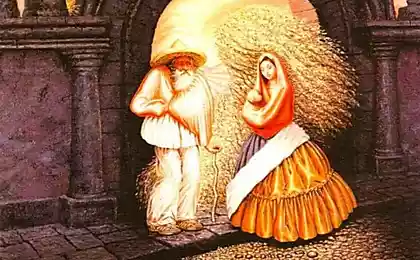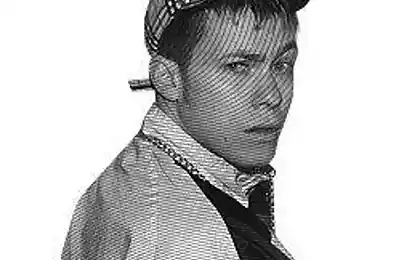983
Music bound us
This is my first tape recorder. I do not consider myself to generation and admirers of the Soviet Union, but when I look at old things for some reason some sort of warmth in my heart overflows.

Here read the article about the music in the USSR. Remember, I will say "yes, yes, that was:-)" smile ... Who's with me!
Music in the USSR was considered something optional for everyday life of a citizen, a kind of a sort of acceptable surplus (except, of course, songs performed by the choir - at the Pioneer lineup in the military ranks, etc.). And therefore the device to play and record music interpreted more as a thing closer to luxury goods than everyday use.
Buying tape in the Soviet era - it was a very serious company! Firstly, the correlative salaries they cost very expensive. For example, this beauty called cassette tape "Spring 211-1-stereo" with speakers cost 365 rubles! In a typical salary of 120 rubles! Three months' salary for an ordinary device to play back tapes! And some high-end reel tape recorder and could cost much more expensive.
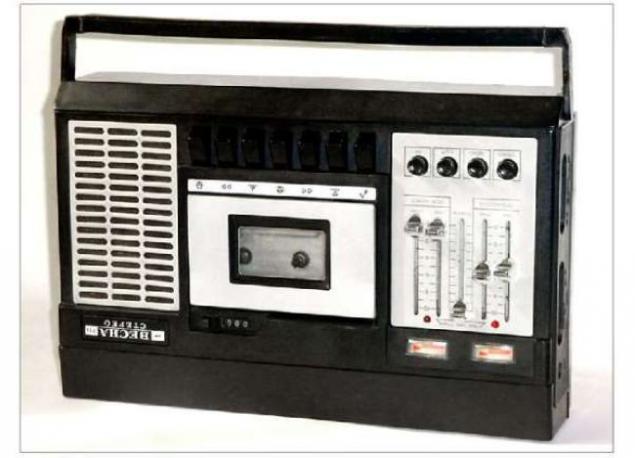
Second, a considerable problem was to buy a model that will not break in the first month of work, which happens quite often. "The Soviet material - soft thing" - said one of the heroes of Platonov, and to the Soviet recorders is applied fully.
However, in fairness, I must say that by the mid-80s in the Soviet Union learned to produce pretty good reel tape recorder. They rarely broke down and given a good sound. But who train in those years like reel tape recorder? They were bulky, non-transportable, even the process of filling the film required some skill. And most importantly, by the time the reels rapidly supplanted by cassettes. In general, among adolescents reel tape recorder was considered a hopeless anachronism. Or, at least, the thing for fans of electronics.

But with cassette decks, things were tight. Okay so that they were dreadful design (see. The picture above - is not it, how elegant the "suitcase" Spring?). The worst part was that they were hideously unreliable in operation. Normal operation of the Soviet cassette - from one repair service center to the next.
Says a lot about this fact. Manufacturers in the guarantee states that if in the first year of operation of the product will undergo repair service center specified number of times (or five, or six), the buyer will be able to exchange it for free on the new model. That is, the manufacturer originally admitted that its product can break five times in the first year! And many of my friends used this right - their recorders broke just the right amount of time.
To clarify that it was not about Kaki some minor breakages like dumps button. Such a trifle corrected at home. I must say that the mechanical control buttons, probably designed by engineers specifically to take leisure consumer. They are constantly falling out, sank, fell away, etc. And they were of very artful design of springs, peredatachnyh levers pulleys. Sometimes as much marveled, how could reach the engineering thought in an effort to complicate simple!
Probably champion breakdowns were nightmarish hybrid recorder, radio and record player. These bulky monsters have a lot more "bottlenecks" than conventional tape, and therefore brought a huge amount of trouble to their owners. But one of the more or less reliable models of the middle class was ruler tape "Mayak».

These cassette decks cost without speakers, if I am not mistaken, 200 rubles with something. Probably wrong to say that they do not break. Of course, broke! But compared to many other models, they would say that, to a greater extent resisted repair folk remedies - for example, kicks to the body. Or breakdowns simple method: disassembled again collected and everything works. Sometimes we had to resort to more clever tricks.
For example, can often be seen in the houses, like a tape recorder stands at an angle, as under his foot something framed. It turns out that he could only work in a tilted position (tilt angle calculated empirically). Or on the contrary, the tape started to work only if it was loaded on top of a heavy pile of books. But the most striking design I have seen a comrade.
He had a tape to stick the spoon, and put a spoonful of iron weight to weight. Only under these crutches manitofon worked. Nevertheless, if the "Lighthouse" could somehow work with all these ridiculous means, the above "Spring" and nearly died completely on any poultice did not react.

Well, riding desire, of course, the Japanese were tape - Sharp, Sony, Panasonic. They stood proudly on the shelves komissionok, showing off the gorgeous price tag. From Soviet counterparts they differed a mile eye catching design, and most importantly, many of them were double cassette - extraordinary uncommon for Soviet technology, which is very appreciated during dubbing from tape to tape.
By the way, the Soviet tapes were much curiosity pohlesche Soviet recorders. More unfortunate thing was hard to find. But that's a topic for the next publication.
And since we were talking about these coffins with the music, it is impossible not to recall the tapes themselves, which for a long time been the most popular storage medium.

Oddly enough, but in the USSR cassettes were not deficient. It was a rare occasion when a product that could potentially be scarce, sold everywhere, but at this price, which excluded any hype. In any store "Radio products' shelves were lined with imported cassettes of different brands They cost all exactly the same regardless of the manufacturer - nine rubles per 90-minute cassette. Price by today's standards, of course, quite awkward. Monthly salary of 120 rubles engineer can be in style vbuhali already in 13 cassettes!
However, you can not show off, and modest buy cassettes of domestic production - four rubles for things. But what was this tape! The song, not the tape! If the State Planning Commission wound up a misdirected Cossack, who directly ordered to producers tapes - "make a tape that she defamed by its very existence to Soviet industry" - he would have to be extremely happy with the result. Since not even happened "as usual", but much worse.
When the Soviet cassette lying on the counter next to their imported counterparts, she gave the impression of not even a poor relation, no! Rather, some podzabornaya profligate, gently attach to the tail of a decent company. To begin with the name. Import cassette called sonorous name of the manufacturer - Basf, Denon, Sony, Toshiba, TDK, Agfa. Soviet bastard was named without the slightest glimmer of imagination - MK, that meant nothing, as the audio cassette. It is strange that no CM - cassette magntifonnaya.

Appearance of the namesake Moskovsky Komsomolets was terrible. Import cassette packaged in bright plastic wrap, under which is the same colorful shells. Their Soviet cousin sold even without the wrapper, and in the design used mainly gray, ryzhye and browns. Apparently the groom said mishandled personally supervised the design.
Insert (a piece of paper in the cassette box to record the song titles) in the import of cassettes was nice glossy paper. It is very convenient for writing pencil, and if necessary, easy to wash rubber band. In Soviet tape liner was made of cardboard, newspaper rough paper. Once write on it was still possible, but when you try to erase the inscription eraser, paper turned into a muddy mess.
However, this situation was just a trifle. Who would want to erase the names of songs and write new ones if the film itself, in principle, was poorly adapted to overwrite? For film in cassettes was a match for the rest. It could provide only a very modest quality of the recording, but when you try to overwrite often - are easily damaged.
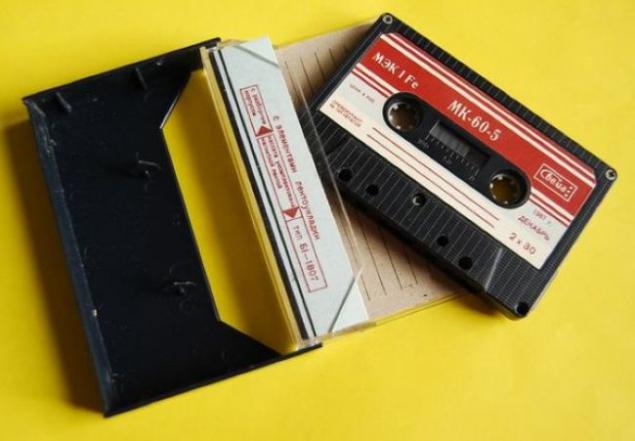
But this film recorders liked! They take great pleasure zazhevyvali her at every opportunity. This case was presciently provided by manufacturers of cassettes, but because the housing is often missing screws. All tapes were imported disassembled, ie, subject to minor repairs - for example, to stretch the film. But many Soviet same tapes were glued, they honestly tried to escort playback creaking and whistling, but, alas, did not respond to repair. If the cassette tape from jamming, the tape can be immediately discarded. And even better - do not buy.
But someone has to buy them? Bought. Or completely unassuming consumers, or even more so miser. In any case, the school magazine sverkanut MK meant doom oneself to ridicule right. However, considering that now you can find memories of the Soviet era, sustained in the most rosy, I would not be surprised if someone would write that the Soviet cassette significantly superior to foreign analogues, and all worked fine until now someone regularly serve . Not at all surprised.
& Lt; iframe width = «420» height = «315» src = « www.youtube.com/embed/?rel= 0 »frameborder =« 0 »allowfullscreen & gt; & lt; / iframe & gt;

Here read the article about the music in the USSR. Remember, I will say "yes, yes, that was:-)" smile ... Who's with me!
Music in the USSR was considered something optional for everyday life of a citizen, a kind of a sort of acceptable surplus (except, of course, songs performed by the choir - at the Pioneer lineup in the military ranks, etc.). And therefore the device to play and record music interpreted more as a thing closer to luxury goods than everyday use.
Buying tape in the Soviet era - it was a very serious company! Firstly, the correlative salaries they cost very expensive. For example, this beauty called cassette tape "Spring 211-1-stereo" with speakers cost 365 rubles! In a typical salary of 120 rubles! Three months' salary for an ordinary device to play back tapes! And some high-end reel tape recorder and could cost much more expensive.

Second, a considerable problem was to buy a model that will not break in the first month of work, which happens quite often. "The Soviet material - soft thing" - said one of the heroes of Platonov, and to the Soviet recorders is applied fully.
However, in fairness, I must say that by the mid-80s in the Soviet Union learned to produce pretty good reel tape recorder. They rarely broke down and given a good sound. But who train in those years like reel tape recorder? They were bulky, non-transportable, even the process of filling the film required some skill. And most importantly, by the time the reels rapidly supplanted by cassettes. In general, among adolescents reel tape recorder was considered a hopeless anachronism. Or, at least, the thing for fans of electronics.

But with cassette decks, things were tight. Okay so that they were dreadful design (see. The picture above - is not it, how elegant the "suitcase" Spring?). The worst part was that they were hideously unreliable in operation. Normal operation of the Soviet cassette - from one repair service center to the next.
Says a lot about this fact. Manufacturers in the guarantee states that if in the first year of operation of the product will undergo repair service center specified number of times (or five, or six), the buyer will be able to exchange it for free on the new model. That is, the manufacturer originally admitted that its product can break five times in the first year! And many of my friends used this right - their recorders broke just the right amount of time.
To clarify that it was not about Kaki some minor breakages like dumps button. Such a trifle corrected at home. I must say that the mechanical control buttons, probably designed by engineers specifically to take leisure consumer. They are constantly falling out, sank, fell away, etc. And they were of very artful design of springs, peredatachnyh levers pulleys. Sometimes as much marveled, how could reach the engineering thought in an effort to complicate simple!
Probably champion breakdowns were nightmarish hybrid recorder, radio and record player. These bulky monsters have a lot more "bottlenecks" than conventional tape, and therefore brought a huge amount of trouble to their owners. But one of the more or less reliable models of the middle class was ruler tape "Mayak».

These cassette decks cost without speakers, if I am not mistaken, 200 rubles with something. Probably wrong to say that they do not break. Of course, broke! But compared to many other models, they would say that, to a greater extent resisted repair folk remedies - for example, kicks to the body. Or breakdowns simple method: disassembled again collected and everything works. Sometimes we had to resort to more clever tricks.
For example, can often be seen in the houses, like a tape recorder stands at an angle, as under his foot something framed. It turns out that he could only work in a tilted position (tilt angle calculated empirically). Or on the contrary, the tape started to work only if it was loaded on top of a heavy pile of books. But the most striking design I have seen a comrade.
He had a tape to stick the spoon, and put a spoonful of iron weight to weight. Only under these crutches manitofon worked. Nevertheless, if the "Lighthouse" could somehow work with all these ridiculous means, the above "Spring" and nearly died completely on any poultice did not react.

Well, riding desire, of course, the Japanese were tape - Sharp, Sony, Panasonic. They stood proudly on the shelves komissionok, showing off the gorgeous price tag. From Soviet counterparts they differed a mile eye catching design, and most importantly, many of them were double cassette - extraordinary uncommon for Soviet technology, which is very appreciated during dubbing from tape to tape.
By the way, the Soviet tapes were much curiosity pohlesche Soviet recorders. More unfortunate thing was hard to find. But that's a topic for the next publication.
And since we were talking about these coffins with the music, it is impossible not to recall the tapes themselves, which for a long time been the most popular storage medium.

Oddly enough, but in the USSR cassettes were not deficient. It was a rare occasion when a product that could potentially be scarce, sold everywhere, but at this price, which excluded any hype. In any store "Radio products' shelves were lined with imported cassettes of different brands They cost all exactly the same regardless of the manufacturer - nine rubles per 90-minute cassette. Price by today's standards, of course, quite awkward. Monthly salary of 120 rubles engineer can be in style vbuhali already in 13 cassettes!
However, you can not show off, and modest buy cassettes of domestic production - four rubles for things. But what was this tape! The song, not the tape! If the State Planning Commission wound up a misdirected Cossack, who directly ordered to producers tapes - "make a tape that she defamed by its very existence to Soviet industry" - he would have to be extremely happy with the result. Since not even happened "as usual", but much worse.
When the Soviet cassette lying on the counter next to their imported counterparts, she gave the impression of not even a poor relation, no! Rather, some podzabornaya profligate, gently attach to the tail of a decent company. To begin with the name. Import cassette called sonorous name of the manufacturer - Basf, Denon, Sony, Toshiba, TDK, Agfa. Soviet bastard was named without the slightest glimmer of imagination - MK, that meant nothing, as the audio cassette. It is strange that no CM - cassette magntifonnaya.

Appearance of the namesake Moskovsky Komsomolets was terrible. Import cassette packaged in bright plastic wrap, under which is the same colorful shells. Their Soviet cousin sold even without the wrapper, and in the design used mainly gray, ryzhye and browns. Apparently the groom said mishandled personally supervised the design.
Insert (a piece of paper in the cassette box to record the song titles) in the import of cassettes was nice glossy paper. It is very convenient for writing pencil, and if necessary, easy to wash rubber band. In Soviet tape liner was made of cardboard, newspaper rough paper. Once write on it was still possible, but when you try to erase the inscription eraser, paper turned into a muddy mess.
However, this situation was just a trifle. Who would want to erase the names of songs and write new ones if the film itself, in principle, was poorly adapted to overwrite? For film in cassettes was a match for the rest. It could provide only a very modest quality of the recording, but when you try to overwrite often - are easily damaged.

But this film recorders liked! They take great pleasure zazhevyvali her at every opportunity. This case was presciently provided by manufacturers of cassettes, but because the housing is often missing screws. All tapes were imported disassembled, ie, subject to minor repairs - for example, to stretch the film. But many Soviet same tapes were glued, they honestly tried to escort playback creaking and whistling, but, alas, did not respond to repair. If the cassette tape from jamming, the tape can be immediately discarded. And even better - do not buy.
But someone has to buy them? Bought. Or completely unassuming consumers, or even more so miser. In any case, the school magazine sverkanut MK meant doom oneself to ridicule right. However, considering that now you can find memories of the Soviet era, sustained in the most rosy, I would not be surprised if someone would write that the Soviet cassette significantly superior to foreign analogues, and all worked fine until now someone regularly serve . Not at all surprised.
& Lt; iframe width = «420» height = «315» src = « www.youtube.com/embed/?rel= 0 »frameborder =« 0 »allowfullscreen & gt; & lt; / iframe & gt;




